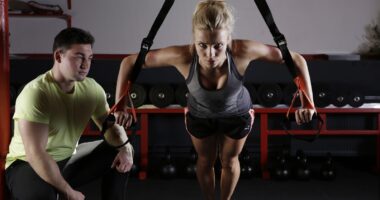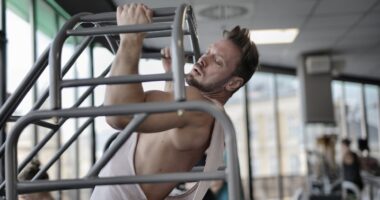It only takes about five seconds to see the world’s strongest man in action. The only problem is that you’re not Ronnie Coleman—and you’ll never be able to be the world’s strongest man. That’s not to say you can’t get the same type of training benefits, though. Here are six training tips from Mr. Coleman that can help you get the same type of training benefits without ever having to actually compete with him.
Ronnie Coleman is widely regarded as one of the fittest athletes in the world, having been named the World’s Fittest Man in 1998, 2000, and 2003. While he retired from competitive bodybuilding in 2006, he has continued a passion for training and has developed a revolutionary training program designed to help you build muscle and build your strength in the fastest, most efficient way.
Ronnie Coleman is one of the greatest bodybuilders of all time. Ronnie won the Mr. He competed in the Olympics eight times in a row and set a new standard for bodybuilding in terms of size, symmetry and fitness. What makes Ronnie so special? How did he manage to dominate bodybuilding for nearly a decade? In my opinion, it was Ronnie Coleman’s training style that set him apart from his competitors.Most professional bodybuilders train each muscle group once a week with light weights and an emphasis on machine exercises. Ronnie Coleman did just the opposite: He trained each muscle group twice a week with incredibly heavy weights, focusing on free weight exercises rather than machines. Ronnie used a high volume approach for each muscle group, but he always used the principle of progressive overload in his training, lifting heavier and heavier weights over time.
Ronnie Coleman explains his training philosophy here: This is called bodybuilding, and the only way to build muscle is through repetition. Heavy weight, as heavy as possible and as many reps as possible. I couldn’t have said it better myself! In this guide, I want to share with you 6 of Ronnie Coleman’s best tips for training to gain muscle mass. Here are some tips for learning, in no particular order:
- First tip: Work each muscle twice a week
- Tip #2: Training with a progressive overload
- Tip #3: Training with free weights instead of machines
- Tip 4: Separate the width and thickness of your spine
- Tip #5: Use partial reps for chest, triceps and quads.
- Tip 6: Train your shoulders with many exercises
Even if you don’t use Ronnie Coleman’s exact training program, I’m sure you’ll find these training tips helpful. Message: If you have trouble reading the workout routines in this article, check out this workout reading guide. Let’s get to work…
Council 1: Exercise each muscle twice a week Ronnie Coleman trained each muscle group twice a week with a training program of 6 days a week. Look at this:
Ronnie Coleman Training Split
- Monday: Chest / Triceps
- Tuesday: Back / Shoulders / Biceps
- Wednesday: Feet
- Thursday: Chest / Triceps
- Friday: Back / Shoulders / Biceps
- Saturday: Feet
- Sunday: On the website
Ronnie Coleman’s split is very similar to a 6 day a week bench press / deadlift / leg press split. The biggest difference is that he trained his shoulders on the day of his back/biceps workout. So why does the distribution of Ronnie’s workouts make such a big difference? Ronnie Coleman’s split workouts allow him to train each muscle group twice as often as his competitors. This means he can build muscle mass and strength much faster than anyone else. One of Ronnie’s favorite strategies was to train each muscle group with two completely different workouts, using completely different exercises. For example, Ronnie Coleman trained his chest with dumbbell exercises in his first weekly workout and with barbells in his second weekly workout. Look at this: R
onnie Coleman Chest exercise
- A1 : Bench press, 3-5 sets of 5-15 reps
- B1 : Bench press, 3-5 sets with 8-20 reps
- C1 : Bench press, 3-5 sets with 8-20 reps
You can click here to watch the training video for this session.
Ronnie Coleman chest workout with dumbbells
- A1: flat press with dumbbells, 3-5 sets of 5-15 reps each
- B1 : Incline bench press with dumbbells, 3-5 sets of 5-15 reps.
- C1 : Dumbbells, 3-5 sets of 8-20 reps each
You can click here to watch the training video for this session. As you can see, Ronnie Coleman trained his chest with two completely different workouts. In his first chest workout, he used a variety of dumbbell exercises, such as bench press, bench press, and bench press. For the second chest muscle workout, he then used a series of dumbbell exercises, such as the flat dumbbell press, incline dumbbell press and flat dumbbell swings. This is a great way to train. Alternating between two different workouts for each body part is ideal for building size and strength. This strategy is great for increasing size because you can overload different muscle fibers in the target muscle with different exercises, thus stimulating its growth. But it’s also good for strength because you prevent your central nervous system from adapting to your routine. Most bodybuilders can make progress for a very long time if they alternate 2 or even 3 different workouts for each body part with different exercises. DC Training is another strength training program that alternates different workouts for each body part.
Tip #2: Progressive overload drive
Ronnie Coleman was one of the strongest bodybuilders the world has ever seen. He was known to throw 200-pound chest weights every day like they were a pair of peanuts, and to lift 800 pounds for reps on days when he trained his legs and back. Here’s a great quote from Ronnie Coleman on the importance of strength training: Everyone wants to be a bodybuilder, but no one wants to lift weights! Many bodybuilders and fitness experts today claim that lifting weights is not necessary to build muscle, or that lifting weights is dangerous and causes injury. As Arnold Schwarzenegger once said: But what are you talking about? If progressive overload isn’t important for muscle building, then anyone could get huge by lifting pink dumbbells for sets of 20 reps! Ronnie Coleman knew that he would have to lift heavier and heavier weights throughout his career if he wanted to build as much muscle mass as possible. Ronnie always came with perfect form and usually trained in higher reps. However, he made sure that his training was done in such a way that he would get stronger over time. Here are some of Ronnie Coleman’s best lifts:
- Bench press: 495 Pfund bei 5 Wiederholungen
- Military developer: 315 Pfund for 12 repetitions
- Crouch: 800 Pfund for 2 repetitions
- Deadlift: 800 Pfund for 2 repetitions
- Bench Press: 450 lbs x 8 reps
- Dumbbells: 495 pounds x 8 re for 4 pounds
Watch Ronnie Coleman row a 495-pound dumbbell for reps: If you’re wondering why Ronnie Coleman was so much bigger than his competitors, that’s where you come in. All the best bodybuilders follow a daily diet and all the best bodybuilders use the same super supplements. What made Ronnie a champion was his ability to train with unsustainable weights, day in and day out, throughout his career. No one could lift the weights that Ronnie lifted, and no one ever came close to his level of muscle development. I’m not saying that progressive overload is the key to building muscle. Yet it is a VERY important piece of the puzzle for building muscle mass. If you haven’t gotten stronger in the last two years, you probably haven’t built much muscle. If you want to learn more about how to build muscle with progressive overload, read the article below: In this article, I’ll show you how to apply the principle of progressive overload to 5 of the most popular strength training programs, including Blood And Guts Training by Dorian Yates, Mountain Dog Training and Fortitude Training. Tip #3:
Training with free weights instead of exercise equipment 
Ronnie Coleman Back Training #1
- A1 : Regular deadlift, 3-5 sets x 4-8 reps
- B1 : Rowing with dumbbell, 3-5 sets x 8-20 reps
- C1 : Rowing on parallel bars, 3-5 sets x 8-20 reps
- D1 : Standing rowing machine, single face DB, 3-5 sets x 8-20 reps.
You can click here to watch the training video for this session.
Ronnie Coleman’s back training #2
- A1: pull-ups (wide/upper grip), 3-5 sets with 8-20 reps
- B1: neck pull-ups (wide/upper grip), 3-5 sets x 8-20 reps
- C1 : Seated pull-up with cable (V-grip), 3-5 sets x 8-20 reps
- D1 : DB pull down, 3-5 sets x 8-20 reps.
You can click here to watch the training video for this session. I don’t know about you, but I don’t see this back workout as some kind of fancy machine workout. I only see old fashioned exercises with free weights, like deadlifts, dumbbell lifts, pulldowns and cable squats. Of course, I don’t consider cable exercises to be exercise material. As Charles Polikin rightly pointed out, cable pull-ups are really just bent dumbbells and should be considered a free weights exercise. So what makes free weights exercises so special? Exercises with loose weights force your body to activate more muscle fibers to lift the weight. All other things being equal, free weight exercises always give better results than exercises with exercise machines. Of course, this does NOT mean that training on the machines is unnecessary. Ronnie Coleman liked to use machine exercises to train his legs. Here are Ronnie’s two weekly leg workouts: Ronnie Coleman Back Squat Workout
- A1: back squat, 3-5 sets x 4-12 reps
- B1 : Leg press, 3-5 sets x 8-20 reps
- C1 : Leg curl, 3-5 sets x 8-20 reps
- D1 : Unilateral leg curl, 3-5 sets x 8-20 reps
- E1: trunk lift on stiff legs, 3-5 sets x 8-20 reps
You can click here to watch the training video for this session.
Ronnie Coleman Front Squat Training
- A1: front squat, 3-5 sets of 4-12 reps each
- B1 : Squat, 3-5 sets of 8-20 reps each
- C1 : Walking lunge (BB on back), 3-5 sets of 8-20 reps.
- D1 : Leg curl, 3-5 sets of 8-20 reps each
- E1 : Squat squat, 3-5 sets of 8-20 reps each
You can click here to watch the training video for this session. As you can see, Ronnie Coleman did about 2 exercises on the trainer per leg workout. He mainly used them to perform old school strength training exercises, such as squats, leg presses and leg extensions. Ronnie Coleman ended up using free weight exercises as the foundation of his training program, and it showed in his physique. If you want to build muscle as quickly as possible, you should also make free weights the foundation of your workout.
Tip #4: Divide your back by the width and thickness 
- Falls (top / middle / bottom)
- Rhomboid
- Spine founder
Most bodybuilders use different exercises to train the width and thickness of the back in the same workout. Ronnie Coleman has a very different approach: He has a separate day for back width training and a separate day for back strength training. Ronnie’s back width workout consists of cable pull-ups, seated cable pull-ups, and supine dumbbell pull-ups to train the glutes and big back. On back strengthening day, Ronnie uses heavy deadlifts, dumbbells and barbells to train the trapezius, rhomboids and erectors of the spine. Here are 2 of Ronnie’s back exercises:
Ronnie Coleman Back Thickening Workout
- A1 : Regular deadlift, 3-5 sets x 4-8 reps
- B1 : Rowing with dumbbell, 3-5 sets x 8-20 reps
- C1 : Rowing on parallel bars, 3-5 sets x 8-20 reps
- D1 : Standing rowing machine, single face DB, 3-5 sets x 8-20 reps.
You can click here to watch the training video for this session.
Ronnie Coleman’s back training
- A1: pull-ups (wide/upper grip), 3-5 sets with 8-20 reps
- B1: neck pull-ups (wide/upper grip), 3-5 sets x 8-20 reps
- C1 : Seated pull-up with cable (V-grip), 3-5 sets x 8-20 reps
- D1 : DB pull down, 3-5 sets x 8-20 reps.
One of the main benefits of Ronnie’s back training program is that his lower back was given a full week of rest between back strengthening workouts. Exercises like torso lifts, dumbbell lifts and barbell lifts require a long recovery time. They put a lot of pressure on your lower back and can significantly limit your ability to recover. By doing all these exercises in one day, Ronnie gave his lower back a full week to recover for the next day of intense back training. If Ronnie did heavy back strengthening exercises twice a week, it would be harder. I highly recommend that you think of your back exercises as back extension or back strengthening exercises, like Ronnie did. This is a very simple, but extremely effective trick to develop a bigger and stronger back.
Tip #5: Use partial reps for chest, triceps and quads 
Ronnie goes up about 70% and then back down to the lowest position of the exercise. Ronnie uses a similar training technique for chest and triceps exercises, such as bench press, dumbbell press and triceps extension. I like to call them bodybuilding style partial reps because many professional bodybuilders use them in their workouts.
Why does Ronnie Coleman train this way? Doesn’t he know that a full range of motion is necessary to build muscle mass? The truth is that Ronnie Coleman himself discovered that the low position in chest, triceps and quadriceps exercises is where the most muscle growth occurs. This is where these muscles are stretched the most, and more and more research supports weight-bearing stretching techniques.
Performing partial reps in the stretch position maximizes the time of tension in the stretch position and maintains maximum tension in the muscle throughout the set. When Ronnie Coleman blocks his legs or gets close to it in a squat, he unloads his quads. If you are an advanced bodybuilder, I highly recommend experimenting with Ronnie Coleman-style partial reps for chest, triceps and quad exercises. Ronnie Coleman trained almost every other muscle group with full range of motion. So don’t try to use this technique for every exercise.
Tip #6: Train your shoulders with various exercises 
Dumbbell shoulder workout by Ronnie Coleman
- A1 : Military bench press, 3-5 sets of 8-20 reps.
- B1 : Standing lateral chest lift, 3-5 sets of 8-20 reps each.
- C1 : Front Deadlift, 3-5 sets of 8-20 reps
- D1 : Back thigh muscles, chest muscles, 3-5 sets of 8-20 reps.
- E1 : Lift the rear flexor tendon diagonally, 3-5 sets of 8-20 reps each.
- F1 : Standing press, 3-5 sets of 8-20 reps each
You can click here to watch the training video for this session.
Ronnie Coleman Dumbbell Shoulder Workout
- A1 : Bench press DB, 3-5 sets with 8-20 reps
- B1 : Side lift on machine, 3-5 sets with 8-20 reps
- B2 : Bench press on machine, 3-5 sets of 8-20 reps
- C1 : Front Deadlift, 3-5 sets of 8-20 reps
- D1 : Tug of war standing on the back of the belt, 3-5 sets of 8-20 reps each
- E1: Backbend tug of war, 3-5 sets of 8-20 reps each
You can click here to watch the training video for this session. Ronnie starts both shoulder workouts with some kind of heavy overhead press. One day he uses an overhead press with dumbbells and the next day an overhead press with dumbbells. After the first whole body exercise, he performs a whole series of isolation exercises for the front, side and back deltoids. Modern research tells us that this is a very useful way to train your deltoids. Delts actually have seven different muscle heads, not just three:
- Front deltas = 3 muscle heads
- Upper lateral arms = 1 muscle head
- Rear deltas = 3 muscle heads
If you want to achieve full deltoid development, you really need to use a wide range of exercises that address each of these different muscle leaders. Ronnie Coleman hasn’t read the latest scientific research to know that. Instead, he trusted his intuition and learned through trial and error that his deltoids developed faster if he did a lot of different exercises for them. This is definitely something to think about for your own shoulder training!
Supplement 
Ronnie Coleman’s exact training program may not be feasible for you. But I’m sure you can use these Ronnie Coleman workout tips to make faster progress in the gym. If you want to learn more about Ronnie Coleman’s training program, read the following articles: Finally, I want to give you a quote from the world boxing champion Muhammad Ali to cheer you up even more:
Champions are not made in gyms. Champions are made by what they have in them – a desire, a dream, a vision. Thanks for reading and good luck with your strength training! Dr. Mike Jansen. I am the creator and owner of Revolutionary Program Design. I help advanced athletes take their training to the next level and achieve results they didn’t even know they had.
Frequently Asked Questions
How do I train like Ronnie Coleman?
“At some point you’ll probably want to train like Ronnie Coleman”. Who could blame you? Ronnie Coleman (born April 12, 1962) is an American bodybuilder and IFBB professional bodybuilder. He is currently ranked seventh on the IFBB Professional Bodybuilding Rankings.
He has won the Mr. Olympia (1981, 1984, 1988), Mr. Universe (1984, 1988), and Mr. Olympia (1993) titles. Everyone has questions about how to train like Ronnie Coleman. But it’s not exactly like it was when Ronnie was on the cover of the bodybuilding mags—the internet is full of information on how to get the physique Ronnie has. Even so, there are still some questions that remain unanswered. For example, what kind of resistance should you use? How often should you train? And what kind of arm and leg workouts should you do? And can you combine bodybuilding with powerlifting?
How did Ronnie Coleman train?
This post is important for anyone who is serious about always being in the best possible shape and progressing in their fitness. This is one of the few times I have written about Ronnie Coleman, but I think you will find his approach quite helpful. I think you might even find it inspiring!
After a hard day’s work, most of us are looking to relax, have a good night’s sleep, and take a long, refreshing shower. But Ronnie Coleman doesn’t have this luxury. He’s a training fiend who trains six hours a day and spends most of his days in the gym. So how does he get the most out of his workout sessions?
How can I get big like Ronnie Coleman?
One of the greatest weightlifters of all time is Ronnie Coleman. He is known for his power, strength, and speed. But what’s even more impressive is that he’s not only a bodybuilder, but a highly successful powerlifter as well. Since he got started in the bodybuilding industry, the entire world of bodybuilding has been transformed – and he was at the forefront of this transformation.
In this article, we’ll take a look at some of the techniques that are now standard for strongman training – and how you can use them to develop the best possible physique. The most well known bodybuilder is Ronnie Coleman, a lifetime champion, and world record holder, he is arguably the most famous bodybuilder of all time, whose life story is absolutely epic. Here are 6 tips to help you dominate the gym and grow like Ronnie Coleman!




